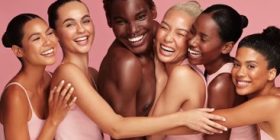PEOPLE
Pillar
People.
People are one of the fundamental pillars of the fashion and cosmetic science industry. The pillar refers to the connection of the industries and their consumers, manufacturers, and creators, as well as how impactful one can have on the other.


In accordance with FourHooks, 2015, Gen Z is a demographic group of people following Millennials and is typically defined as the generation born after 1995 followed by the next generation, born after 2010. Gen Zs are often referred to as ‘technoholics’, having grown up with technology and the internet as an integral part of their lives. (FourHooks, 2015). With 32% of the global population being Gen Z (Chang, 2019), makes them one of the largest demographics in the world which impacts how industries advertise and market products, in order to cater to Gen Zers.

‘Uniqueness’ as one of the factors of consumption, highlights Gen Zs values of authenticity from brands and how they can easily spot any insincerity within a company. Full transparency, honesty, and truth to a company’s identity is essential in building trust between brands and this generation. ‘Digital Engagement’ is probably the most important consideration when it comes to attracting Gen Zs. Utilising social media, influencer marketing, and interactive online experiences to engage with Gen Z as they are digital natives who spend a significant amount of time online.
Expectations of brands to be socially conscious and ethical, showcasing their commitment to diversity, and social causes is something of importance to the ever-conscious cohort. ‘75% of Gen Z consumers will boycott companies that discriminate against race and sexuality across advertisement campaigns, according to a McKinsey study.’ (Cook, 2019). This has impacted companies to showcase and bring inclusivity to the table, shifting the dynamics and beauty standards that indoctrinated the world for so long. Fenty’s 2017 launch of 40 different foundation tones, as it was an industry first, helped enable that shift within the cosmetic community. (CB Insights, 2021).

While seemingly straightforward, inclusivity, digital presence, and innovation are essential for brands to succeed in retaining the interest and loyalty of their target audiences. As the world is continuously evolving and progressing, so should mindset and adaptability of businesses as a whole.
References
CB Insights (2021). How The Inclusive Beauty Movement Is Redefining The Industry. [online] CB Insights Research. Available at: https://www.cbinsights.com/research/what-is-inclusive-beauty/.
Chang, J. (2019). 113 Key Generation Z Statistics 2021/2022: Characteristics & Facts You Should Know. [online] Financesonline.com. Available at: https://financesonline.com/generation-z-statistics/#:~:text=Gen%20Zers%20or%20iGeners%20comprise%2032%25%20of%20the.
Cook, S. (2021). How Millennials & Gen Z Are Pushing Brands On Diversity And Inclusion. [online] www.businessbecause.com. Available at: https://www.businessbecause.com/news/insights/7504/millennial-gen-z-diversity-and-inclusion.
FourHooks (2015). The Generation Guide – Millennials, Gen X, Y, Z and Baby Boomers. [online] FourHooks. Available at: http://fourhooks.com/marketing/the-generation-guide-millennials-gen-x-y-z-and-baby-boomers-art5910718593/.
Francis, T. and Hoefel, F. (2018). ‘True Gen’: Generation Z and its implications for companies. [online] McKinsey & Company. Available at: http://www.drthomaswu.com/uicmpaccsmac/Gen%20Z.pdf.
Moran, G. (n.d.). Gen Z and Millennials 2023. [online] Drapers. Available at: https://www.drapersonline.com/guides/gen-z-and-millennials-2023.

